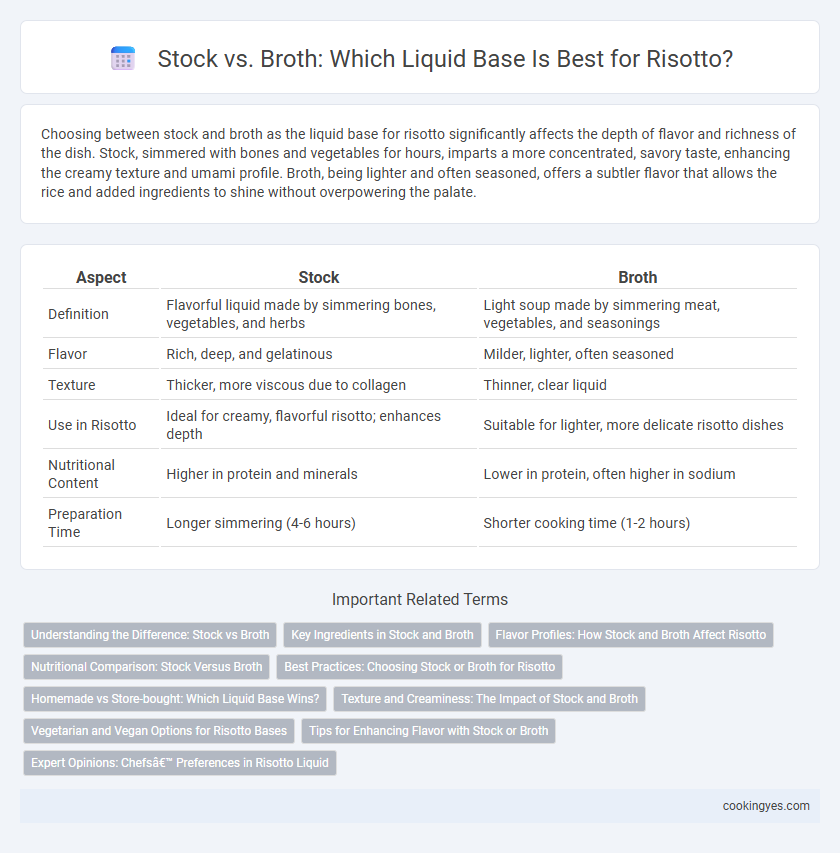Choosing between stock and broth as the liquid base for risotto significantly affects the depth of flavor and richness of the dish. Stock, simmered with bones and vegetables for hours, imparts a more concentrated, savory taste, enhancing the creamy texture and umami profile. Broth, being lighter and often seasoned, offers a subtler flavor that allows the rice and added ingredients to shine without overpowering the palate.
Table of Comparison
| Aspect | Stock | Broth |
|---|---|---|
| Definition | Flavorful liquid made by simmering bones, vegetables, and herbs | Light soup made by simmering meat, vegetables, and seasonings |
| Flavor | Rich, deep, and gelatinous | Milder, lighter, often seasoned |
| Texture | Thicker, more viscous due to collagen | Thinner, clear liquid |
| Use in Risotto | Ideal for creamy, flavorful risotto; enhances depth | Suitable for lighter, more delicate risotto dishes |
| Nutritional Content | Higher in protein and minerals | Lower in protein, often higher in sodium |
| Preparation Time | Longer simmering (4-6 hours) | Shorter cooking time (1-2 hours) |
Understanding the Difference: Stock vs Broth
Stock is made by simmering bones, vegetables, and aromatics, resulting in a rich, gelatinous base ideal for creamy risotto. Broth is prepared by boiling meat and vegetables, offering a lighter, clearer flavor that enhances delicate risotto recipes. Choosing stock or broth affects the risotto's depth and texture, with stock providing more body and broth delivering a subtle taste.
Key Ingredients in Stock and Broth
Stock is typically made by simmering bones, vegetables, and aromatic herbs for several hours, resulting in a rich, gelatinous base packed with collagen and deep umami flavors essential for creamy risotto. Broth, on the other hand, is usually prepared by boiling meat, vegetables, and seasonings for a shorter time, producing a lighter, clearer liquid with a more pronounced individual ingredient taste. Choosing stock over broth enhances risotto's texture and depth, as the collagen in stock contributes to the creamy consistency and complex mouthfeel characteristic of traditional risotto dishes.
Flavor Profiles: How Stock and Broth Affect Risotto
Stock offers a richer, more concentrated flavor for risotto due to its slow simmering of bones, vegetables, and herbs, enhancing the dish's depth and complexity. Broth, being lighter and often seasoned, imparts a more delicate taste that can highlight subtle ingredients without overwhelming them. Choosing stock or broth directly influences the risotto's flavor intensity and overall balance, shaping the culinary experience.
Nutritional Comparison: Stock Versus Broth
Stock typically contains more collagen and minerals extracted from simmered bones, providing higher protein content and a richer nutrient profile compared to broth. Broth is generally lighter, made primarily from simmered meat and vegetables, offering fewer calories and lower fat levels. Choosing stock for risotto enhances nutritional density, contributing to a more flavorful and healthful dish.
Best Practices: Choosing Stock or Broth for Risotto
Choosing the right liquid base for risotto significantly impacts flavor and texture, with stock offering a richer, more complex taste due to its slow simmering of bones and vegetables. Broth, made primarily from meat and seasoning, provides a lighter, more delicate flavor that can complement subtle risotto ingredients. For best results, use homemade stock or broth with minimal salt to control seasoning and enhance the creamy consistency essential for authentic risotto.
Homemade vs Store-bought: Which Liquid Base Wins?
Homemade stock offers a richer flavor profile and essential nutrients derived from slow-simmered bones, vegetables, and herbs, enhancing risotto's depth and creaminess. Store-bought broth provides convenience and consistency but often lacks the complexity and freshness crucial for authentic risotto taste. Choosing homemade stock elevates the dish by delivering a more robust umami character, whereas store-bought options may require additional seasoning to achieve a similar impact.
Texture and Creaminess: The Impact of Stock and Broth
Using stock as the liquid base in risotto enhances the dish's texture and creaminess due to its rich gelatin content extracted from simmered bones, providing a velvety mouthfeel. Broth, typically lighter and clearer, results in a less creamy texture but offers a cleaner, milder flavor allowing the rice's natural starch to shine. Opting for homemade or high-quality stock significantly improves the risotto's luscious consistency and depth compared to standard broth options.
Vegetarian and Vegan Options for Risotto Bases
Vegetarian and vegan risotto bases often use vegetable stock or broth made from simmering vegetables like carrots, celery, onions, and herbs, providing rich flavors without animal products. Homemade or store-bought vegetable broth ensures a depth of taste while aligning with plant-based dietary preferences. Using mushroom broth adds umami notes that enhance the creamy texture and overall complexity of vegan risotto dishes.
Tips for Enhancing Flavor with Stock or Broth
Choosing homemade chicken or vegetable stock over broth intensifies risotto's depth with richer, natural flavors and gelatin from slow-simmered bones. Infuse stock with aromatics like garlic, shallots, or fresh herbs during preparation to elevate complexity and balance. Warm the liquid before gradually incorporating it into the rice, ensuring consistent cooking and optimal flavor absorption throughout the creamy risotto.
Expert Opinions: Chefs’ Preferences in Risotto Liquid
Chefs often prefer stock over broth for risotto due to its richer flavor profile and higher concentration of nutrients extracted from simmered bones and vegetables, enhancing the dish's depth. Expert opinions emphasize that homemade chicken or vegetable stock provides a creamy texture and balanced seasoning, crucial for the traditional risotto creaminess. While broth can be used, professionals agree that stock's intensity better complements the slow absorption process, resulting in a more authentic and flavorful risotto.
Stock vs Broth for liquid base Infographic

 cookingyes.com
cookingyes.com